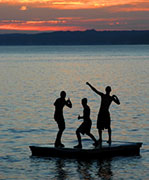
FRIDAY, July 24, 2015 (HealthDay News) — A deadly “brain-eating” amoeba that lives in freshwater sources may be surviving in more northern areas of the United States thanks to climate change, health experts suggest.
Minnesota health officials are still trying to confirm if the death of a Minnesota teen this summer was caused by the single-celled organism Naegleria fowleri. If confirmed, it would be the northernmost infection of Naegleria fowleri ever reported, according to the Minneapolis Star-Tribune.
The amoeba normally lives in warmer waters in the southern United States. But since climate change is generally making summers hotter, the amoeba now seems to be in northern waters, said Dr. Bruce Hirsch, an infectious diseases specialist at North Shore University Hospital in Manhasset, N.Y. “Climate change may be playing a role,” he said.
The U.S. Centers for Disease Control and Prevention referred to the amoeba as “heat-loving.” In the United States, more than half of infections caused by the amoeba have occurred in Florida and Texas, the CDC reports. The first known case to occur in Minnesota didn’t happen until 2010.
Although Naegleria fowleri is endemic in many U.S. lakes and rivers, the odds of the bug getting into your brain are slight. In fact, between 2005 and 2014, only 35 people were infected in the United States, according to the CDC.
The infection caused by the amoeba is called primary amebic meningoencephalitis, which destroys brain tissue, the CDC says.
So how does someone get infected? When water containing the amoeba enters the nose, the CDC said. You cannot get this infection from drinking contaminated water, according to the agency.
Hirsch explained that the bug probably gets into the brain when water is forced into the nose as someone jumps into a lake, river or even a pool. The amoeba can then penetrate the lining of the nose and make its way through the porous bone between the nose and the brain, he explained.
Once in the brain, it can cause an infection that destroys brain cells and is almost always fatal. “There have been a few survivors, but it is a very dangerous infection,” Hirsch said.
The infection cannot be spread from one person to another, he added.
Treatment is available with several drugs, and sometimes it’s effective, Hirsch said.
“The mainstay of treatment is an antifungal, antimicrobial medicine called amphotericin,” he said. “Used in combination with other medicines given directly into the spinal fluid, if caught early, it has been able to help people survive this devastating infection,” he said.
Symptoms start about five days after infection, the CDC says. The first symptoms may include headache, fever, nausea or vomiting. Later symptoms can include stiff neck, confusion, seizures and hallucinations, the CDC says.
“The person would be totally out of it — confused — and then fall into a coma,” Hirsch said.
Most cases are from contaminated water in lakes or rivers, but some people were infected after nasal irrigation with contaminated tap water, and others have gotten infections from swimming pools, bathtubs and even a backyard Slip’N Slide using contaminated water, according to the CDC.
Among known cases, 97 percent of people infected have died. Only three out of 133 infected people in the United States from 1962 to 2014 have survived, the CDC noted.
Dr. Adriana Cadilla, a pediatric infectious disease specialist at Nicklaus Children’s Hospital in Miami, said there was a fatal case at her hospital several years ago.
Doctors are not usually looking for this infection, she said.
“Testing is not routine and that’s part of the reason that it’s difficult to diagnose, and it takes a couple of days to get results, which may be part of the reason why we don’t have as much of a success as we would like with the treatment,” she explained.
No real precautions exist beyond telling the public that a particular body of water has these amoeba, Cadilla said. The CDC cautions against getting water splashed up the nose.
“We don’t know why someone gets infected and others don’t,” Cadilla said. “We really can’t tell you what to do not to get infected.”
She stressed that this is a very rare infection and other hazards linked to water are much more common.
“There have been 35 cases, but from 2001 to 2010 there were 34,000 drownings,” Cadilla said. “There are other risks associated with water that have a higher priority.”
More information
For more information on Naegleria fowleri, visit the U.S. Centers for Disease Control and Prevention.
Copyright © 2025 HealthDay. All rights reserved.

